Porcelain Insulator News
by Elton Gish
Reprinted from "Crown Jewels of the Wire", July 2000, page 11
I had a wonderful time at the Enumclaw show this past May with Mt. Rainier
looking spectacular Saturday under clear skies. This was Vi Brown's last
sponsorship of the 30-year show which she and her husband, Andy, have made a
long tradition. I heard that someone has volunteered to sponsor the show next
year so hopefully the tradition will not be lost.
While I was in the area, I had
a chance to see the collections of Ben Kirsten and Robin Harrison and we will
report a few interesting items this month that Ben had. Eight people brought
insulators for the Fred Locke display: Robin Harrison, Mike
Spadafora, Ed Sewall, Ben Kirsten, Gil Hedges-Blanquez,
Howard Banks, Tim Wood, and myself.
There were too many notable specimens in the display to mention. It was the
largest display of Fred Locke insulators since the famous display Fred Locke set
up at the electrical exhibition in St. Louis in 1904. And as an added interest
in Fred Locke insulators, you could have seen the great display set up by the
Jefferson State Insulator Club (JSIC). Their very large display consisted of
several tables of Fred Locke porcelain and glass insulators the Club found
recently along an old line in southern Oregon and in a dump site in northern
California. Nearly all of the insulators were broken but some could be repaired.
There was one unique item found which we will discuss later. You can see all of
the displays at: www.r-infinity.com/enumclaw2000/index.htm
Part of the Fred
Locke display was Ben Kirsten's unique wooden electrical equipment support he
found in a little shack in Utah. He left it intact with the only two known
specimens of M-3236 with Fred Locke multiple date markings. Note the large cast
iron caps cemented to the insulator crown that supports the wooden platform.
Such devices were used to support electrical equipment and for a person to stand
on when they threw a switch in the high voltage circuit. You can learn more
about where and how Ben found this unique item in a future issue of Ed Sewall's
Power Line Explorer Journal (contact Ed for a subscription).
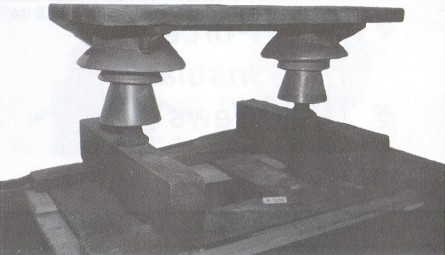
Two Fred Locke M-3236's insulating a wooden platform.
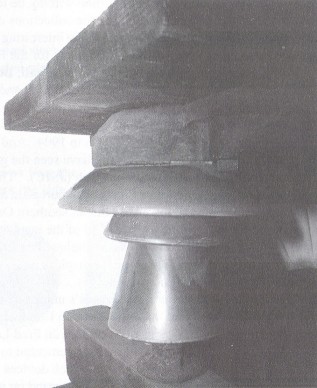
Close up of one of the Fred Locke M-3236 's.
Note the heavy cast iron support
cemented to the crown.
Ben had several very interesting insulators and here are a few that I
photographed. I've seen a lot of strains in all types of styles. Most have a
brown glaze and some have a white glaze and maybe a few have a modern cobalt
blue glaze, but I don't remember ever seeing a strain insulator with a beautiful
medium blue glaze! It really stands out.

Beautiful medium blue glazed strain insulator.
Another one of Ben's interesting insulators was an unmarked light blue U-500.
A total of four light blue U-500's were reported for the Value Guide survey, but
this is the first one I have seen.
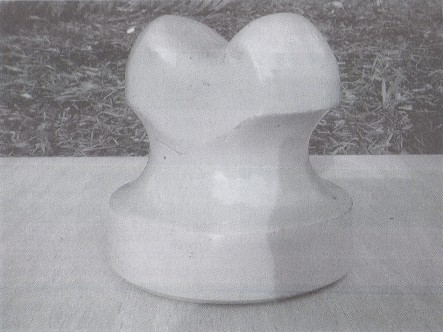
Light blue unmarked U-500. The dark area is a shadow.
Blue insulators with the "G.P.Co." marking are rare. Three blue U-282's with the "G.P.Co." marking have been reported but they have the
darker blue glaze. Ben has the only one I know of with a light blue glaze! It is
truly a jewel! It is pictured on the right next to an unmarked U-282 with an
interesting glaze, too. The color is basic gray with highlights of blue! At least
that is the best way I can describe it. The color print didn't capture the
colors as well as the digital image.
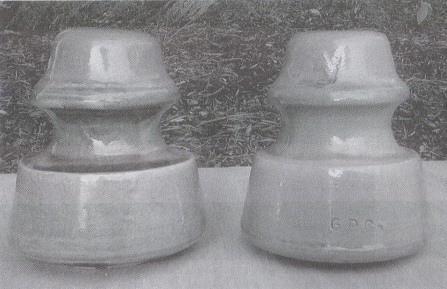
Unmarked U-282 with gray/blue glaze (left)
and light blue U-282 G. P. Co.
(right).
The next insulator is U-238B with "G.P.Co." marking. These are rare
in a dark blue glaze. However, Ben has a beautiful brown U-238B where the guy
working the trimmer blade evidently pushed the blade too far into the spinning
clay body. Note the unusually deep and wide wire groove.
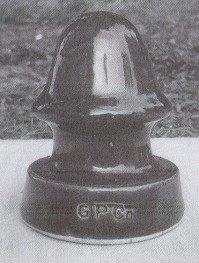
U-238B G.P.Co. with
unusually cut wire groove.
Ben also had a chocolate brown M-2322. These have only been reported in
cobalt blue with either Lapp or Locke R=oo marking. Both styles are rare in that
color. While Ben's insulator is not as pretty as a cobalt blue one, it is the
first confirmed report of this style in brown.
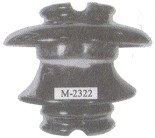
One of the highlights of the Fred
Locke display at the Enumclaw show were the five versions of M-2842. Until
recently, only M-2842 had been identified. This is the standard all porcelain
style similar to CD 342. M-2842 is fairly rare with less than 10 known if that
many. All have the #6-2 marking with 1901 manufacturing date. Paul Greaves (NIA
#2685) found a repairable specimen in northern California with the #6-1 marking
except it has a smaller crown. This is M-2842A. Bill Rohde (NIA #1219) located
one with the small crown and #6-1 marking except it has a glass bottom skirt.
This is M-2842B. A few years ago, Walter Ruedrich found the top to an M-2842
(large crown) in northern California, which had the #6-2 marking. However it had
the remains of a glass bottom skirt cemented in sulfur cement. This is M-2842C.
Howard Banks (NIA #900) has been finding broken M-2842's in southern Oregon
which have 4-date markings. We didn't notice until the Enumclaw show that the
ones Howard was finding had a much larger crown. This style has been assigned M-2842D. All of this will be explained in the new 2nd edition book,
Multipart
Porcelain Insulators.

Four similar Fred Locke styles (l-r): M-2842B,
M-2842A, M-2842, and M-2842D
Hugh Barbour reported an interesting very old bus bar insulator similar to
U-710. It appears to be an unmarked Imperial but they are not noted for unmarked
insulators. Pittsburg also made U-710 and is my guess at the most likely
manufacturer. Hugh reported: "I was wandering through the WKP #2 plant
today and was shown an old part of the plant I had never been in before. I was
excited to see a bunch of old U-964's high up on the wall. They were too high to
get to which was disappointing because they looked to be very light tan. Much to my amazement there were also some white pin-types
holding an old bus, which fed the station service. I was able to salvage two of
them. They are unmarked but I would guess they are Imperials. They have metal
caps on them that are 3-3/4" wide and 2-3/4" high. The cap tapers to 2-1/2" on the top. If you look under the cap you can see that some of the
cap was put on with yellow sulfur cement." The metal cap is cast iron and
the top disk is made of brass. The four hex-head bolts secure the disk to the
cap clamping the bus bar in between.
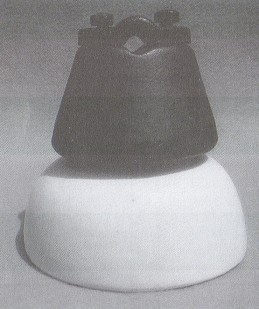
Unusual bus bar support. Note that the
metal cap is cemented to the U-710
insulator with sulfur cement.
The last insulator we will report this month is by no means the least
interesting. I'm hoping one of you will be able to tell me how it was used. My
guess is that it supported a triangle-shaped bus bar. Jeff Bozarth (NIA #6579)
reported this unusual insulator. It appears to be either a U-359 or U-361A. The
cast iron cap with large triangle formed in the top was cemented to the crown of
the insulator.
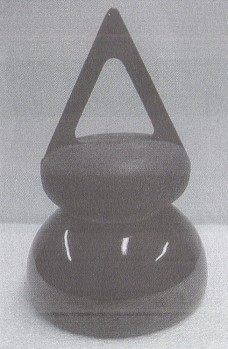
Bus bar insulator with very
unusual cast iron supporting cap.
| 